My first exposure to the term “Pandora’s Box” was from one of my favorite YouTubers, EmpLemon, as he went into detail on the ancient Greek Myth and its modern implications in a video essay. Pandora was the first woman created on Earth; she was given a box by the gods and told not to open it. However, once she did open it, the box unleashed all known evil onto the world, drawing parallels to the story of Adam and Eve. While G. W. Pabst’s acclaimed 1929 film doesn’t fully capture the consequential magnitude of this myth, it still makes for a captivating story. Lulu, played by Louise Brooks, is a woman whose undeniable charm makes her appealing. Like sirens luring sailors to their death with their enchanting voice, her magnetism on screen can only be described as irresistible. As the events of the film unfold and follow Lulu, she truly is Pandora in every sense–beautiful yet completely unruly.
The story follows her and her antics over the course of eight different acts, which are separated by title cards–a lost art in modern cinema. While each act has its own unique feel, they each share a common theme: Lulu is always causing chaos. The opening act immediately portrays Lulu as promiscuous as she is caught in an affair with Dr. Ludwig Schön (Figure 2), who is soon to be married to his fiancée. He eventually breaks off the marriage and then decides to marry Lulu, even after he boldly states: “One does not marry such a woman, it would be suicide.” With some not-so-subtle foreshadowing, Lulu is the eventual cause of death of Dr. Schön, and she then quickly moves on to his son Alwa, getting him into some major gambling debt in the process. With no blatant sexual exertion apart from kissing, she is able to fully seduce these men by her demeanor alone. The subsequent acts follow this continuously unravelling spiral as Lulu’s actions eventually catch up to her at the end by means of Jack the Ripper–a karmic ending in every sense.
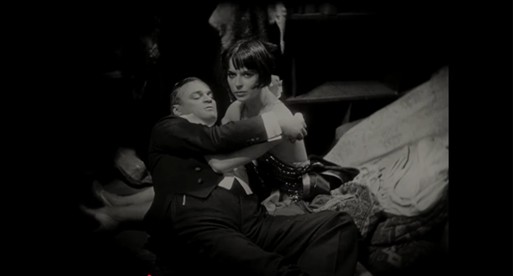
The peak of this film for me comes in act five, when Lulu gets tried in court for the death of Dr. Schön. As the prosecution compares her to Pandora, she once again casts that enchanting smile, with no sense of remorse on her face for her actions (Figure 3). This close-up shot has a chilling nature to it; she knows what she’s done, and she’s about to get away with it. Indeed, she ends up getting away with murder, but not in the traditional sense. Someone intentionally pulls the fire alarm in the courtroom, causing a panic, and Lulu uses this as an opportunity to escape and elope with Alwa.
Every man who encounters Lulu falls for her, and I don’t blame them. It’s very clear that one recurring theme of this film is Lulu utilizing her sexuality to get what she wants. Beyond attracting just men, she attracts women as well, introducing queer themes that were ahead of the time. Relative to the societal expectations of women during the 1920s, this is an incredibly stark contrast. While women had more rights than ever before at this time, they were still suppressed by systemic societal norms that had been in place for centuries prior. Lulu’s independence and unrestrained sexuality is a foil to the stereotypical portrayal of a 1920s woman, and while it’s celebrated for the majority of the film, it also leads to her demise at the end.

With this dissimilarity in thematic messaging, what is the final takeaway here? It ultimately boils down to the outcome of Lulu’s actions: she’s this free and liberated spirit that gets punished, deservedly so, for her wrongdoings. However, I was not fond of this outcome in the way it was portrayed. Although, considering the timing and cultural context of this film, I can understand G. W. Pabst’s rationale. I personally would have loved to see Lulu cause even more havoc, leaving an ending that’s open to interpretation. The film is about her repeatedly opening “cans of worms,” so I say let the worms flow until the very end!
I really enjoyed this film. Despite my criticisms of the ending, I can still appreciate it as generally excellent. Interestingly, the Criterion version of Pandora’s Box is an incomplete restoration. The original film has many frames missing that have been lost to time, but my viewing experience was not impacted at all. As a twenty-two-year-old who loves modern blockbusters like Star Wars (1977) and The Dark Knight trilogy, silent films normally don’t stimulate my brain enough. However, G. W. Pabst’s direction paired with Louise Brooks’s performance genuinely drew me in. I had my reservations as the film began, but the lack of vibrant colors and audible dialogue became irrelevant while my immersion deepened. I didn’t have any urges to check Instagram or TikTok: I was just living in the moment, enjoying this work of art.
Pandora’s Box (Spine #358) is available from The Criterion Collection.
Author Biography
Corbin Bean is a fourth-year student at Georgia Tech’s school of Literature, Media, and Communication. While he specializes in marketing and strategy, he has an underlying passion for film, writing, and video production. He plans to continue to pursue his passions beyond college with every opportunity that presents itself.
Film Details
Pandora’s Box (1929)
Germany
Director G. W. Pabst
Runtime 141 minutes
Blu-ray
USA, 2024
Distributed by The Criterion Collection (region A/1)

